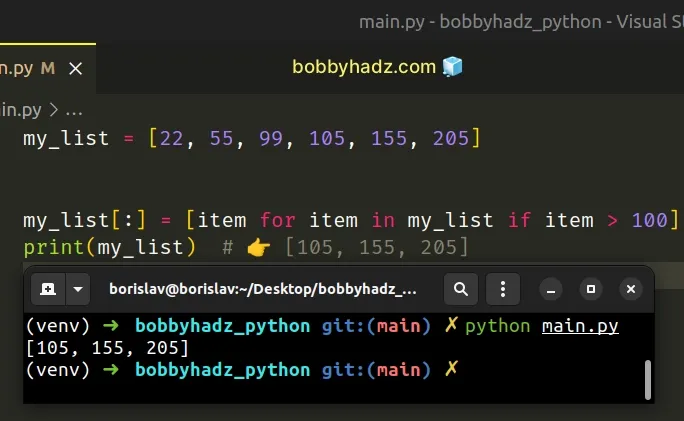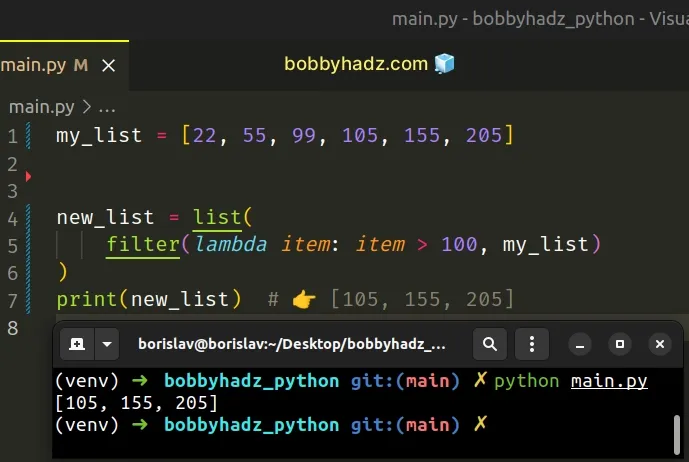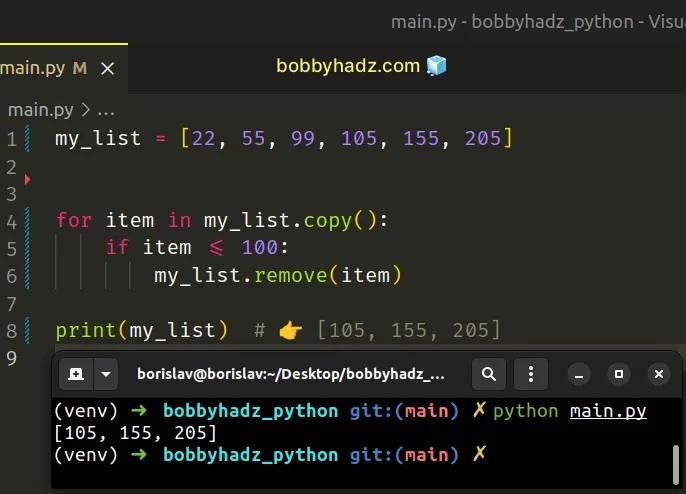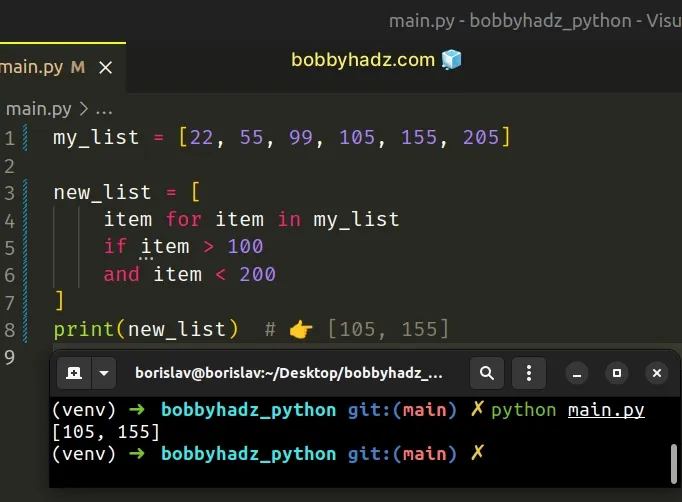Remove elements from a List based on a condition in Python
Last updated: Apr 9, 2024
Reading time·4 min

# Table of Contents
- Remove elements from List based on a condition in Python
- Remove elements from List based on a condition using filter()
- Remove elements from List based on a condition using for loop
- Remove elements from List based on multiple conditions
# Remove elements from list based on a condition in Python
Use a list comprehension to remove elements from a list based on a condition.
The list comprehension will return a new list that doesn't contain any of the elements that don't meet the condition.
my_list = [22, 55, 99, 105, 155, 205] new_list = [item for item in my_list if item > 100] print(new_list) # 👉️ [105, 155, 205]

We used a list comprehension to remove elements from a list based on a condition.
my_list = [22, 55, 99, 105, 155, 205] new_list = [item for item in my_list if item > 100] print(new_list) # 👉️ [105, 155, 205]
On each iteration, we check if the current list item is greater than 100 and
return the result.
The new list will only contain values that are greater than 100.
The list comprehension doesn't change the original list, it creates a new list.
# Removing elements from the original list
If you need to change the original list, use a list slice.
my_list = [22, 55, 99, 105, 155, 205] my_list[:] = [item for item in my_list if item > 100] print(my_list) # 👉️ [105, 155, 205]

We used the my_list[:] syntax to get a slice that represents the entire list,
so we can assign to the variable directly.
my_list[:] represents the entire list, so when we use it on the left-hand side, we are assigning to the entire list.This approach changes the contents of the original list.
Alternatively, you can use the filter() function.
# Remove elements from list based on a condition using filter()
This is a three-step process:
- Use the
filter()function to filter out elements that don't meet the condition. - Use the
list()class to convert thefilterobject to a list. - The new list won't contain any elements that don't meet the condition.
my_list = [22, 55, 99, 105, 155, 205] new_list = list( filter(lambda item: item > 100, my_list) ) print(new_list) # 👉️ [105, 155, 205]

We used the filter() function to remove elements from a list based on a
condition.
The filter() function takes a function and an iterable as arguments and constructs an iterator from the elements of the iterable for which the function returns a truthy value.
The lambda function gets called with each element in the list, checks if the
value is greater than 100 and returns the result.
The filter object only contains values that are greater than 100.
The last step is to use the list() class to
convert the filter object to a list.
Alternatively, you can use a for loop.
# Remove elements from list based on a condition using for loop
This is a three-step process:
- Use a
forloop to iterate over a copy of the list. - On each iteration, check if the current item meets a condition.
- Use the
list.remove()method to remove the matching elements.
my_list = [22, 55, 99, 105, 155, 205] for item in my_list.copy(): if item <= 100: my_list.remove(item) print(my_list) # 👉️ [105, 155, 205]

100 and use the list.remove() method to remove the matching elements.The list.remove() method removes the first item from the list whose value is equal to the passed-in argument.
The remove() method mutates the original list and
returns None.
The most important thing to note when removing items from a list in a for loop
is to use the list.copy() method to iterate over a copy of the list.
If you try to iterate over the original list and remove items from it, you might run into difficult-to-locate bugs.
# Remove elements from list based on multiple conditions
If you need to remove elements from a list based on multiple conditions, use the boolean AND and boolean OR operators.
my_list = [22, 55, 99, 105, 155, 205] new_list = [ item for item in my_list if item > 100 and item < 200 ] print(new_list) # 👉️ [105, 155]

The code sample uses the boolean AND operator to check for 2 conditions.
When the boolean AND operator is used, both conditions have to be met for the
element to get included in the new list.
Only elements that are greater than 100 and less than 200 get added to the
list in the example.
If you need to check for multiple conditions where only 1 has to be met, use the
boolean OR operator.
my_list = [22, 55, 99, 105, 155, 205] new_list = [ item for item in my_list if item > 100 or item == 22 ] print(new_list) # 👉️ [22, 105, 155, 205]
When the boolean OR operator is used, either condition has to be met for the
element to get added to the new list
# Additional Resources
You can learn more about the related topics by checking out the following tutorials:
- Remove a Dictionary from a List of Dictionaries in Python
- Remove duplicates from a List of Dictionaries in Python
- Remove all Empty Strings from a List of Strings in Python
- Remove first or last N elements from a List in Python
- Remove the Max and Min numbers from a List in Python
- Remove Newline characters from a List or a String in Python
- How to Remove the None values from a List in Python
- Remove punctuation from a List of strings in Python
- How to remove Quotes from a List of Strings in Python

